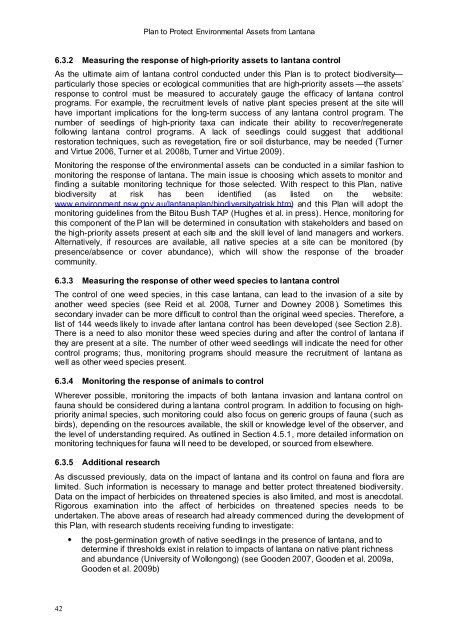Plan to Protect Environmental Assets from Lantana - Weeds Australia
Plan to Protect Environmental Assets from Lantana - Weeds Australia
Plan to Protect Environmental Assets from Lantana - Weeds Australia
You also want an ePaper? Increase the reach of your titles
YUMPU automatically turns print PDFs into web optimized ePapers that Google loves.
<strong>Plan</strong> <strong>to</strong> <strong>Protect</strong> <strong>Environmental</strong> <strong>Assets</strong> <strong>from</strong> <strong>Lantana</strong><br />
6.3.2 Measuring the response of high-priority assets <strong>to</strong> lantana control<br />
As the ultimate aim of lantana control conducted under this <strong>Plan</strong> is <strong>to</strong> protect biodiversity—<br />
particularly those species or ecological communities that are high-priority assets —the assets’<br />
response <strong>to</strong> control must be measured <strong>to</strong> accurately gauge the efficacy of lantana control<br />
programs. For example, the recruitment levels of native plant species present at the site will<br />
have important implications for the long-term success of any lantana control program. The<br />
number of seedlings of high-priority taxa can indicate their ability <strong>to</strong> recover/regenerate<br />
following lantana control programs. A lack of seedlings could suggest that additional<br />
res<strong>to</strong>ration techniques, such as revegetation, fire or soil disturbance, may be needed (Turner<br />
and Virtue 2006, Turner et al. 2008b, Turner and Virtue 2009).<br />
Moni<strong>to</strong>ring the response of the environmental assets can be conducted in a similar fashion <strong>to</strong><br />
moni<strong>to</strong>ring the response of lantana. The main issue is choosing which assets <strong>to</strong> moni<strong>to</strong>r and<br />
finding a suitable moni<strong>to</strong>ring technique for those selected. With respect <strong>to</strong> this <strong>Plan</strong>, native<br />
biodiversity at risk has been identified (as listed on the website:<br />
www.environment.nsw.gov.au/lantanaplan/biodiversityatrisk.htm) and this <strong>Plan</strong> will adopt the<br />
moni<strong>to</strong>ring guidelines <strong>from</strong> the Bi<strong>to</strong>u Bush TAP (Hughes et al. in press). Hence, moni<strong>to</strong>ring for<br />
this component of the P lan will be determined in consultation with stakeholders and based on<br />
the high-priority assets present at each site and the skill level of land managers and workers.<br />
Alternatively, if resources are available, all native species at a site can be moni<strong>to</strong>red (by<br />
presence/absence or cover abundance), which will show the response of the broader<br />
community.<br />
6.3.3 Measuring the response of other weed species <strong>to</strong> lantana control<br />
The control of one weed species, in this case lantana, can lead <strong>to</strong> the invasion of a site by<br />
another weed species (see Reid et al. 2008, Turner and Downey 2008 ). Sometimes this<br />
secondary invader can be more difficult <strong>to</strong> control than the original weed species. Therefore, a<br />
list of 144 weeds likely <strong>to</strong> invade after lantana control has been developed (see Section 2.8).<br />
There is a need <strong>to</strong> also moni<strong>to</strong>r these weed species during and after the control of lantana if<br />
they are present at a site. The number of other weed seedlings will indicate the need for other<br />
control programs; thus, moni<strong>to</strong>ring programs should measure the recruitment of lantana as<br />
well as other weed species present.<br />
6.3.4 Moni<strong>to</strong>ring the response of animals <strong>to</strong> control<br />
Wherever possible, moni<strong>to</strong>ring the impacts of both lantana invasion and lantana control on<br />
fauna should be considered during a lantana control program. In addition <strong>to</strong> focusing on highpriority<br />
animal species, such moni<strong>to</strong>ring could also focus on generic groups of fauna (such as<br />
birds), depending on the resources available, the skill or knowledge level of the observer, and<br />
the level of understanding required. As outlined in Section 4.5.1, more detailed information on<br />
moni<strong>to</strong>ring techniques for fauna will need <strong>to</strong> be developed, or sourced <strong>from</strong> elsewhere.<br />
6.3.5 Additional research<br />
As discussed previously, data on the impact of lantana and its control on fauna and flora are<br />
limited. Such information is necessary <strong>to</strong> manage and better protect threatened biodiversity.<br />
Data on the impact of herbicides on threatened species is also limited, and most is anecdotal.<br />
Rigorous examination in<strong>to</strong> the affect of herbicides on threatened species needs <strong>to</strong> be<br />
undertaken. The above areas of research had already commenced during the development of<br />
this <strong>Plan</strong>, with research students receiving funding <strong>to</strong> investigate:<br />
the post-germination growth of native seedlings in the presence of lantana, and <strong>to</strong><br />
determine if thresholds exist in relation <strong>to</strong> impacts of lantana on native plant richness<br />
and abundance (University of Wollongong) (see Gooden 2007, Gooden et al. 2009a,<br />
Gooden et al. 2009b)<br />
42

















